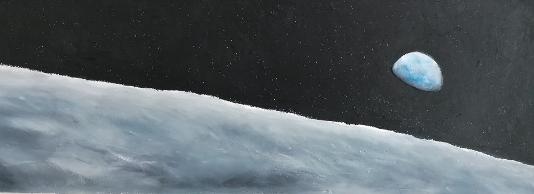Looking at Earth: From 100 miles to 100 million miles

Ownership: Sold to Private Individual, USA
"Earth Rising", 2021
41 W x 16 H x 1 D cm
16.1 W x 6.3 H x 0.4 D in
Pastel on Paper, Collage
One-of-a-kind piece
COA: This can artwork includes a certificate of authenticity.
Shipping: Free from Lisbon, Portugal (EU country).
Tax: EU VAT included in price. International shipping may be subject to customs duties and taxes.
Return Fee: Buyer is responsible for return shipping charges and will not be reimbursed for the original shipping cost.
Refunds: 100%, after 3 days of arrival.
Secure transactions by credit card or google pay through Stripe. Use the blue button Buy above.
Have a question?
About the seller on Trustpilot
ABOUT "Only a select few men and women have looked at Earth from space firsthand. From that exceptional viewpoint they have marveled at both the beauty and the fragility of our planet. The rest of us rely on images made by astronauts’ cameras and the satellites circling the globe ― and, from deeper space, by robotic missions looking back across the solar system.
Early balloon and later rocket launches gave us a view of Earth from as high as 100 miles above the planet. Today we can look back at home from 100 million miles away.
The first successful U.S. satellite ― Satellite 1958 Alpha, better known as Explorer 1 ― brought back the first science from space as sounds, but it wasn’t long before scientists were putting cameras on high-flying rockets and satellites.
The science produced by Earth-observing satellites and deep-space missions continues to bring us new understanding and perspective about how our planet’s systems interact and change, as well as our place in the universe. The images collected here have contributed significantly to science across disciplines.
Sometimes, however, we just step back and look at the beauty of it." Nasa.
"The vast loneliness is awe-inspiring, and it makes you realize just what you have back there on Earth." – Jim Lovell
On Dec. 24, 1968, Apollo 8 astronauts Frank Borman, Jim Lovell, and Bill Anders became the first humans to orbit the Moon and the first to witness the Earth rising above the Moon's barren surface. That evening they held a live broadcast from lunar orbit, in which they showed pictures of the Earth and Moon as seen from their spacecraft. The mission is known for this iconic "Earthrise" image, snapped by Anders, which would give humankind a new perspective on our home planet. Anders has said that despite all the training and preparation for an exploration of the Moon, the astronauts ended up discovering Earth.
Fifty-three years later, we celebrate!